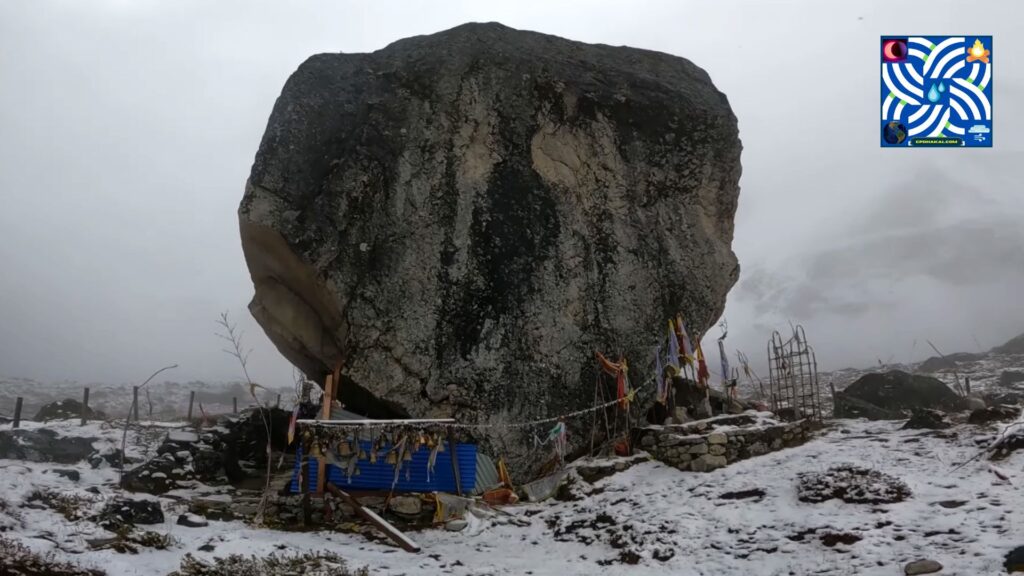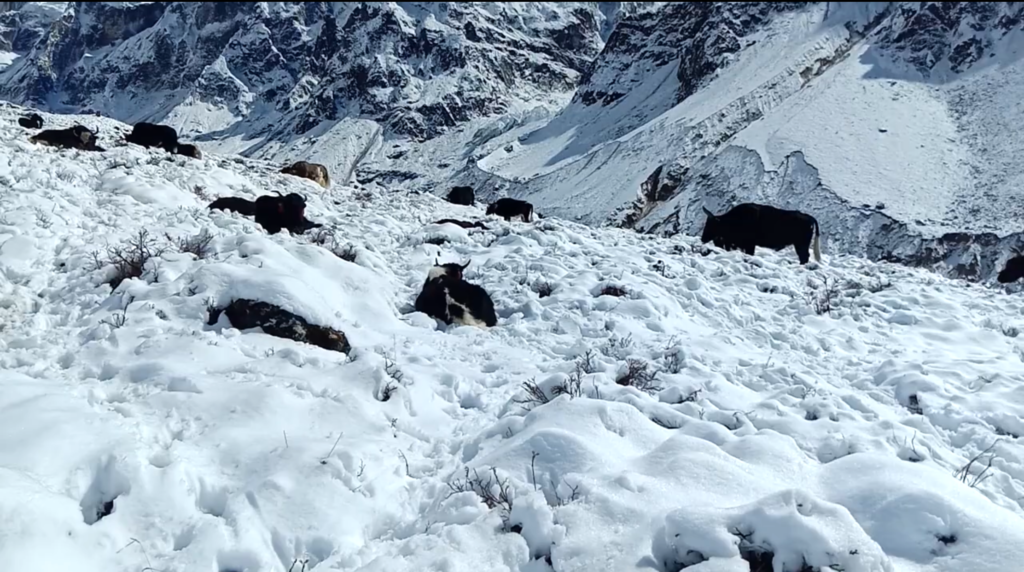Unveiling the Majesty of Mount Kumbhakarna
Exploring the Enigmatic Giant of the Himalayas

Table of Contents
Introduction and location of Mt Kumbhakarna
- Mt Kumbhakarna or Jannu also called Phoktanglungma in the local Limbu language is the 32nd highest mountain in the world. It is located in the Koshi province, Taplejung district, Phaktanlung rural municipality ward no. 6 Lelep, the eastern part of Nepal near the border with Sikkim state of India. It is the western outlier part of the Kanchenjunga mountain range. It is famous for its unique beauty with the wonderful physical structure of mother nature and one of the rarely climbed mountains.
- The peak/mountain is approximately 7,710 meters (25,295 feet) above sea level with latitude 27.682778° N and longitude 88.045833° E.
Religious and Cultural Significance
- The name “Kumbhakarna” comes from Hindu mythology, where Kumbhakarna, the younger brother of ‘Ravan’ was a powerful demon character having a big body structure in the epic Ramayana. He was killed by Ram and believed that his dead body fell on top of this peak as per his desire/request. In Hindu culture, mountains often hold religious significance, and Mount Kumbhakarna is no exception. It is regarded with reverence by locals and is often associated with stories and myths passed down through generations and called the mountain ‘Kumbhakarna’.
- British botanist and explorer Sir Joseph Dalton Hooker saw a mountain and then named Mt Jannu in honor of a Hindu deity, during the British Great Trigonometric survey of India in the 19th century.
- The name ‘Phoktanglungma’ comes from the Limbu language, literally “mountain with shoulders” (Phoktang means ‘shoulder’ and Lungma means ‘mountain’) and is sacred in the Kirat religion. Saying that the huge holy stone/Rock had fallen from the peak of Phoktanglungma and is situated at Phaktanglung (the base area of the peak) which is a famous holy place for Kirati mainly the Limbu people, they hike to pray and worship Kirat God and Goddess to fulfill their wishes started from 1993 BS(VS) when Mahaguru Phalgunanda Lingden visited this holy place with his followers where under a huge rock/stone. They built a Manghim near the holy rock/stone, since then this place has been known as their holy land.

Natural Beauty and Wilderness
- Mount Kumbhakarna/Jannu/Phoktanglungma is a majestic mountain, with awe-inspiring peaks, and ancient spiritual traditions, that have long captured the imagination of people worldwide, inspiring countless myths, legends, and spiritual practices. it is renowned for its breathtaking beauty and pristine wilderness. The towering peak seems to touch the heavens itself, creating a sense of wonder and reverence. The unique surrounding view of the Pathibhara and Kanchenjunga hill/mountain and gorge made by the silver-shining mountain range can get many positive emotions like calmness, joy, and creativity and can facilitate concentration and many more advantages during the communication with Himalayan range.
- The surrounding trekking trail area is characterized by a Clean picturesque environment, natural waterfalls, the sight of silver and golden-colored mountains, and rivers formed by melting snow have captivated everyone. Tea and cardamom gardens, dense forests, rugged terrain, and diverse flora and fauna. It serves as a vital habitat for various species of plants and animals such as the variety of Rhododendrons, fir, home lock, oak trees, yak, sheep, snow leopard, clouded leopard, blue sheep, wild goat, marmot, and weasel contributing to the rich biodiversity of the Kumbhakarna.
- Kumbhakarna and its journey give us natural pure cool air with a natural scented fragrance which makes the journey more comfortable. Continuing charge with positive emotion makes us happier and more inspired. The adventure, makes us feel free and alive, fills us with peace of mind, and at the same time guides us in difficult situations and challenges. By exploring this peak, taking unforgettable memories, and learning strength and patience, we will know why there is a saying, ‘Nature is the best treatment for both the body and the soul’.

Mountaineering Challenge of Mt Kumbhakarna
- Successfully summiting Mt Kumbhakarna/Mt Jannu/Phoktanglungma is considered a significant achievement in mountaineering. For mountaineers and adventure ascenders, man-shaped mountain presents a more notable challenge. Its steep slopes, technical difficulty of climbing routes, and unpredictable weather conditions make it one of the most challenging mountain peaks in the Himalayas.
- 1st reconnoitered in 1957 by Guido Magnone and 1st attempted in 1959 by a French team led by Jean Franco. Robert Paragot, Rene Desmaison, Gyalzen Michu Sherpa, and Paul Kellar were the 1st ascenders of the peak on 04.27.1962, the team led by the French alpinist Lionel Terray via the southeast ridge. A Japanese team led by Masatsugu Konishi climbed through the north face called the Wall of Shadows then met the east ridge in 1976.
- A Russian team led by Alexander Odintsov climbed the direct north face route through the Headwall in 2004 and three American climbers, Alan Rousseau, Matt Cornell, and Jackson Marvell successfully climbed without supplemental oxygen, roped fixed in advance and porters on 12th October 2023.
Tourism and Adventure
- Mt Kumbhakarna/Jannu also called Phaktanglungma is the 32nd highest unique, breathtaking, bright, and most beautiful mountain in the world and attracts tourists and adventurers from around the world. It offers opportunities for trekking, hiking, and mountaineering, providing visitors with an unforgettable experience amidst the awe-inspiring landscapes of the Himalayas. As per Kailash Kher,” Nepal is a beautiful country with a lot of holy places. I also like the country because it’s close to the Himalayas. According to Hindu mythology, that’s the abode of lord Shiva”.
- There are various routes of climbing such as the North faced route, South faced route. One of them from the Nepal side, through the Kanchenjunga Conservation Area, a protected area in eastern Nepal is the southwest face of the summit. The approximate traveling/trekking/mountaineering duration is as follows: [Day 1-3: in Kathmandu, for approval of submitted documents from the Nepal Government and completed preparation for the expedition. Day 4: Flight; from Kathmandu to Biratnagar, Day 5: Flight; from Biratnagar to Suketar, Trek; from Seketar to Tambawa, Day 6: Trek; from Tambawa to Khesewa, Day 7: Trek; from Khesewa to Mamankhe, Day 8: Trek; from Mamankhe to Yamphudin, Day 9: Trek; from Yamphudin to Chitre (Omje Khola), Day 10: Trek; from Chitre to Torontan, Day 11: Trek; from Torontan to Tseram Camp, Day 12: Trek; from Tseram to Ramze, Day 13: Trek; from Ramze to Kumbhakarna Base camp, Day 14: Trek; from Kumbhakarna Basecamp to High Camp (Advanced Base Camp), Day 15-36: Climbing/mountaineering period of Kumbhakarna, Day 37: Trek; from Kumbhakarna Base Camp to Yallung, Day 38: Trek; from Yallung to Lamite Bhanjhyang, Day 39: Trek; from Lamite Bhanjhyang to Yamphudin, Day 40: Trek; from Yamphudin to Phonpe Dhara, Day 41: Trek, from Phonpe Dhara to Khunjar, Day 42: Trek; from Khunjar to Suketar, Day 43: Flight from Suketar to Biratnagar, Day 44: Flight; from Biratnagar to Kathmandu and Day 45: Roaming around Kathmandu. (Please verify this information with more recent sources as there may have been changes or updates. If you have specific details or updates in mind, I recommend checking with the Nepal Government, local authorities, or recent travel resources for the most accurate and current information.)]
- This summit involves exploring, experiencing, learning to deal with, and overcoming Mother Nature. it gives master skills in hiking, trekking, rock/ice climbing, snowboarding, snowshoeing and more. It provides an opportunity to deeply connect with nature and experience its beauty, peace, and power. This area is inhabited by local tribal communities with unique cultures, traditions, and lifestyles. Though, including interaction with these communities, and gaining insight into their way of life.
Contribution to Local Economy

- The tourism industry related to Kumbhakarna Himal has been contributing to the local economy of the surrounding area. It has provided significant economic opportunities to local communities by creating jobs in various sectors such as hospitality, transportation, guiding, and retailing. This flow of tourism revenue has contributed to the overall economic growth of the region. Employment opportunities for guides, porters, lodge owners, and others involved in the tourism sector, support the livelihoods of local communities.
- Growing tourism often leads to improvements in infrastructure such as roads, transportation networks, hotels, restaurants, and entertainment facilities. These developments not only enhance the tourist experience but also benefit residents by providing better access to essential services and amenities.
- Mt Kubhakarna-tourism is helping preserve local culture and traditions by encouraging communities to preserve their cultural heritage. Visitors are often interested in experiencing authentic cultural activities, which encourage locals to continue practicing traditional crafts, performing arts, and ceremonies.
- Sustainable mountain tourism practices are promoting environmental conservation efforts. Governments and local communities are implementing regulations and initiatives to protect fragile mountain ecosystems, wildlife habitats, and natural resources. This helps ensure the long-term viability of tourism in the region and preserves the beauty of the landscape for future generations.
- Mountain tourism generates revenue for local governments through various means such as entrance fees to national parks, permits for guided tours, taxes on accommodation and services, and sales of locally produced goods. This revenue can and is being reinvested in the community through public services, infrastructure projects, conservation efforts, and educational programs.
- Mountain tourism diversifies local economies that are heavily dependent on agro-based traditional industries. By providing an alternative source of income, tourism has contributed to reducing the vulnerability of communities to economic downturns in other areas and contributing to overall economic resilience.
- Its Kumbhakarna Mountain tourism has brought people of different backgrounds and cultures together, promoting intercultural exchange and understanding. This has brought greater tolerance, appreciation, and awareness of diversity among both visitors and locals.
Conclusion
- Overall, Mt Kumbhakarna/Jannu/Phoktanglungma holds significance as a symbol of natural beauty, cultural heritage, and adventure in the Himalayan region, attracting visitors and enthusiasts while also contributing to the local economy and ecosystem. tourism industry associated with it significantly contributes to the local economy. It provides employment opportunities for guides, porters, lodge owners, and other individuals involved in the tourism sector, supporting the livelihoods of local communities.
